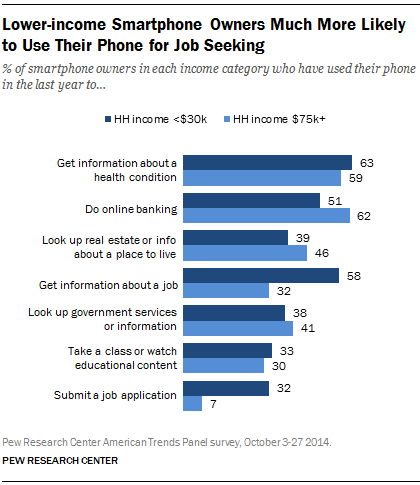How Low-Income Americans Actually Use Cell Phones

By:
"You know what, Americans have choices — and they’ve got to make a choice," Rep. Jason Chaffetz (R-Utah) told CNN Tuesday. "And so maybe, rather than getting that new iPhone that they just love and they want to spend hundreds of dollars on, maybe they should invest in their own health care."
Chaffetz was making the case that the repeal and replacement plan of the Affordable Care Act (ACA) put forward by House Republicans on Monday required Americans to become more self-reliant and to sacrifice items such as cell phones if they were struggling to afford health insurance. But that comment ignores the differences in how poor and wealthy Americans actually use their cell phones.
For people whose household income is less than $30,000, cell phones represent an increasingly valuable resource, according to a 2015 survey from the Pew Research Center.
Among those in that income bracket, 63 percent use cell phones to get information about medical conditions; 58 percent use their device to look for jobs; 33 percent take online courses or watch educations videos with their phones; and 32 percent reported using their cell phone to submit job applications.
 Pew Research Center - pewinternet.org
Pew Research Center - pewinternet.org
Only 7 percent of cell phone owners earning $75,000 or more annually have submitted a job application on their device — a sizeable gap that could account for Chaffetz's confusion over the utility of cell phones for low-income Americans. In contrast, those earning more than $75,000 are more likely to use their cell phones for online banking and to look up real estate information.
There's another, perhaps more obvious, layer to the controversy over Chaffetz's comments. He implied that forgoing a new iPhone would save Americans enough money to afford health insurance.
Writer Adam Weinstein pointed out the problem with this logic in a blog post for Task & Purpose on Tuesday, using the retail price of a 256GB iPhone 7 ($849) to estimate what health services that money could get you, based on his insurance plan.
Here are a few examples, according to Weinstein:
- "5 percent of an appendectomy: Got a gamy appendix? Removing it — just removing it, not including hospital care or doctor’s visits — costs the average insured Floridian $17,984."
- "Almost two years of asthma treatment: That’s based on an average cost of $482 for four office doctor visits to evaluate and manage symptoms."
- "About one-fifth of a breast biopsy: Just removing and analyzing a breast tissue sample can cost $3,709 — not including a mammogram or doctor’s visits."
- "Almost an entire IUD: The average intrauterine device implantation costs $982 in Florida, all-in."
- "About half a colonoscopy: The procedure alone costs insurers an average of $1,786 if polyp removal is included."
- "Two and a half pregnancy ultrasounds: Hey, at $343, showing your parents the new kid’s blip of a winky is practically a steal."
Chaffetz has since walked back his comment, conceding in an interview with Fox News on Tuesday that he didn't express his view "as smoothly as I possibly could." He clarified that he meant "people need to make a conscious choice, and I believe in self-reliance."
In the digital age, though, research indicates that being self-reliant when it comes to education, employment, and personal health increasingly involves a cell phone.
